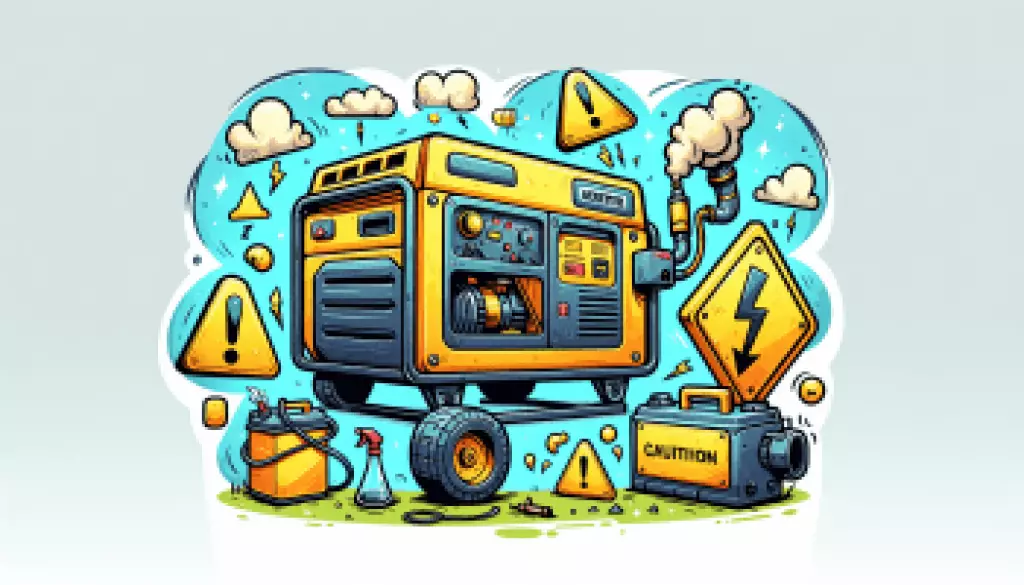Top 5 Reasons Why Generator Fails To Start
If your generator fails to start, this article will help you identify why and how to fix it. We’ll cover the top five common issues and give you straightforward steps to get your generator running.
Key Takeaways
- Fuel issues, including stale fuel and blockages, are the most common reasons for generator starting failures.
- Regular maintenance of the battery, oil levels, air filters, and spark plugs is essential to prevent starting problems in generators.
- Timely troubleshooting and corrective actions can effectively resolve common generator issues and enhance their reliability.
Here are five common reasons why your generator may fail to start, along with troubleshooting tips and solutions for each issue:

Generators are complex machines, and they can fail to start for a variety of reasons. However, there are five common reasons that account for most starting issues. Understanding these can save you time and frustration when your generator won’t start.
Here’s what you need to know about fuel issues, dead batteries, oil level problems, air filter blockages, and faulty spark plugs.
1. Fuel Issues
Fuel issues are among the most common reasons a generator fails to start. Whether you’re dealing with a diesel generator or another type, ensuring the fuel system is functioning properly is crucial. Problems can arise from insufficient fuel, stale fuel, or blockages in the fuel lines. An empty fuel tank or a clogged fuel line can prevent the engine from getting the fuel it needs to start.
A bad fuel mix or contaminated fuel can also lead to starting issues. Using fresh gasoline and ensuring that the fuel tank and lines are free from impurities is important. Diesel engines, in particular, require careful attention to the fuel quality and system integrity.
Symptoms: Engine cranks but doesn’t start; no fuel in the tank.
When your generator cranks but doesn’t start, the first thing to check is the fuel level in the tank. An empty fuel tank is a common issue and can be easily overlooked. Additionally, if the fuel is old or contaminated, it can cause the engine to crank without starting.
Blockages in the fuel line can also prevent the fuel from reaching the engine. This could be due to debris or air in the fuel lines, which disrupts the fuel flow. For propane generators, ensure that all tank valves and connecting lines are open and unobstructed.
Troubleshooting:
To troubleshoot fuel-related issues, start by checking the fuel level and ensuring there’s enough fuel in the tank. Next, inspect the fuel quality; if the fuel is stale or over three months old, consider draining and replacing it with fresh gasoline.
Inspect the fuel lines for any blockages or leaks that might be hindering fuel flow.
Fix:
If you identify stale fuel, replace it with fresh fuel to ensure proper engine ignition. Ensure that the fuel valve is open. This will allow gas to flow from the tank to the carburettor. Cleaning the carburettor and fuel filter regularly can prevent blockages that hinder engine ignition.
If these steps do not resolve the issue, inspect and clean the fuel filter to ensure it is not clogged and is allowing sufficient fuel flow. Always check the choke valve position; it should be ‘CLOSED’ during engine start-up for proper operation.
2. Dead Battery

A dead battery is another common reason why a generator won’t start. Many generators rely on a battery for ignition, and if the battery fails, the generator will not start. Regularly checking battery connections and charge levels can prevent unexpected battery failure.
Battery issues are especially prevalent after long periods of inactivity. Keeping your battery charged and well-maintained ensures reliable generator operation. Explore the symptoms and troubleshooting steps for battery-related problems.
Symptoms: No lights or sounds when attempting to start.
When you attempt to start your generator and there’s no response—no lights, no sounds—it typically indicates a dead battery. This can happen after prolonged inactivity, or if the battery charger has been turned off or malfunctioning.
A fully charged battery should show a voltage between 13.5 and 14.8V; anything below 12V suggests insufficient power to start the engine.
Troubleshooting:
Start by checking the battery connections to ensure they are clean and tight. A multimeter is used to test the battery voltage; it should read around 12.6 volts.
If the voltage is low, the battery may need charging or replacing.
Fix
If the battery is discharged, charge it fully before attempting to start the generator again. If the battery is old or damaged, replacing it with a new one will ensure that the generator has sufficient power to start.
3. Oil Level Problems

Maintaining proper oil levels is crucial for the smooth operation of generators. A low oil level can trigger the generator’s low-oil shutoff mechanism, preventing it from starting. Ensuring the oil is at the recommended level and is clean can prevent starting issues.
Oil level problems can be easily avoided by regular checks and maintenance. Let’s look at the symptoms, troubleshooting steps, and fixes for oil level-related issues.
Symptoms: The generator won’t start; the oil warning light is on.
If your generator won’t start and the oil warning light is illuminated, it’s a clear indication of low oil levels. Operating the generator on an uneven surface can falsely activate the low-oil sensor. Additionally, insufficient lubrication due to low oil levels can result in increased friction and potential engine damage.
Monitoring oil levels regularly ensures the generator operates effectively. If the oil sensor is malfunctioning, disconnecting it can sometimes allow the generator to start.
Troubleshooting
To troubleshoot oil level problems, use the dipstick to check the oil level and ensure it meets the manufacturer’s specifications. Inspect the oil quality; if it is dark or gritty, it may need changing.
Frequent checks can help avoid starting issues.
Fix
If the oil level is low, refill it with the appropriate type of oil as recommended by the generator’s manufacturer.
If the oil is dirty, change it to ensure optimal engine performance.
4. Air Filter Blockage

A clogged air filter can significantly affect generator performance. It restricts airflow, preventing the engine from starting. Regular inspection and maintenance of the air filter are necessary to ensure the generator runs efficiently.
Addressing air filter blockages can prevent long-term damage to the generator’s internal components. Let’s explore the symptoms, troubleshooting steps, and fixes for air filter-related issues.
Symptoms: Engine cranks but doesn’t start; reduced airflow.
When the engine cranks but doesn’t start, and there’s reduced airflow, a clogged air filter is often the culprit. Symptoms include strange engine noises, vibrations, and lower fuel efficiency. In severe cases, the generator may produce black smoke due to incomplete fuel combustion.
In dusty environments, regular checks and cleaning of the air filter maintain optimal airflow and performance. Ignoring the air filter can lead to long-term damage to the generator’s internal components.
Troubleshooting
To troubleshoot air filter issues, remove the air filter and check for dirt and debris.
Test the airflow by trying to start the generator with the filter removed to see if it starts.
Fix
Clean or replace the air filter as needed to ensure proper airflow. Maintaining the air filter regularly prevents airflow issues and ensures efficient generator operation.
5. Faulty Spark Plug

Spark plug problems are another common reason why generators fail to start. Over time, spark plugs can wear out or become damaged, leading to ignition issues. Inspecting and maintaining the spark plug regularly can prevent such problems.
Faulty spark plugs can significantly impact the generator’s performance. Explore the symptoms, troubleshooting steps, and fixes for spark plug-related issues.
Symptoms: Engine cranks but doesn’t start; poor performance.
When the engine cranks but doesn’t start, and there’s poor performance, it often indicates a faulty spark plug. Symptoms include abnormal sounds like crackling and premature shutdown of the generator.
Replacing old or dirty spark plugs can restore proper function.
Troubleshooting
To troubleshoot spark plug issues, remove the spark plug and inspect for wear, carbon buildup, or damage.
Test the spark by reconnecting the plug wire and grounding the plug to see if it sparks when cranking the engine.
Fix
Clean or replace the spark plug if it’s worn or damaged. Maintaining the spark plug regularly ensures a strong spark and reliable engine performance.
General Maintenance Tips
Preventing generator issues hinges on regular maintenance. Frequently inspect fuel, oil, and air filters for optimal performance. Keeping the diesel generators clean and free from debris can also enhance itheirefficiency.
Adhere to the manufacturer’s maintenance schedule for oil changes and other services. Diagnosing common issues and applying the corresponding fixes can effectively troubleshoot and resolve starting problems.
Summary
Understanding why a generator fails to start and knowing how to troubleshoot and fix these issues can save you a lot of time and frustration. We’ve covered the five most common reasons for a generator failing to start: fuel issues, dead batteries, oil level problems, air filter blockages, and faulty spark plugs. Each of these has specific symptoms, troubleshooting steps, and fixes that can help you get your generator back up and running.
By regularly inspecting your generator and performing routine maintenance, you can prevent many of these issues from occurring in the first place. Keeping a close eye on fuel levels, battery conditions, oil levels, and the cleanliness of air filters and spark plugs will ensure your generator is ready to go when you need it most.
Remember, the key to a reliable generator is consistent maintenance and prompt attention to any issues that arise. With these tips and solutions, you’ll be well-prepared to handle any generator problems and ensure your power supply remains uninterrupted.
Visit the Generator-Pro website for more information on Top 5 Reasons Why Generator Fails To Start





